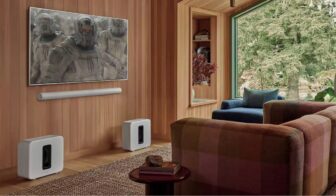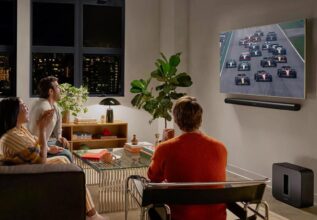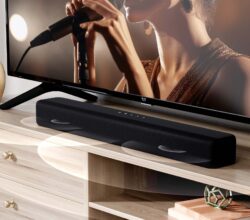Sony Theatre Quad Review
Traditional sound bars are usually the go-to solution for filling your home with captivating cinema sound. However, despite their advantages, they often reach their limits when it comes to surround sound, as they can only produce it virtually without additional rear speakers.
In contrast, Sony’s Theatre Quad (HT-A9M2) takes a different approach, offering a versatile, easily positioned set of four speakers for true 3D audio sound. Each satellite speaker has four speaker drivers, delivering a total reference output of 504 watts.
The package also includes a central control box with two HDMI ports and a LAN connection. The system supports Wi-Fi, Bluetooth (5.2), AirPlay, and Spotify Connect, allowing music to be streamed wirelessly to the speakers. Our review will explore whether 3D audio or Dolby Atmos is supported, if the package includes wall mounts for the speakers, the option for a separate subwoofer, and how the Sony Theatre Quad performs in practice.
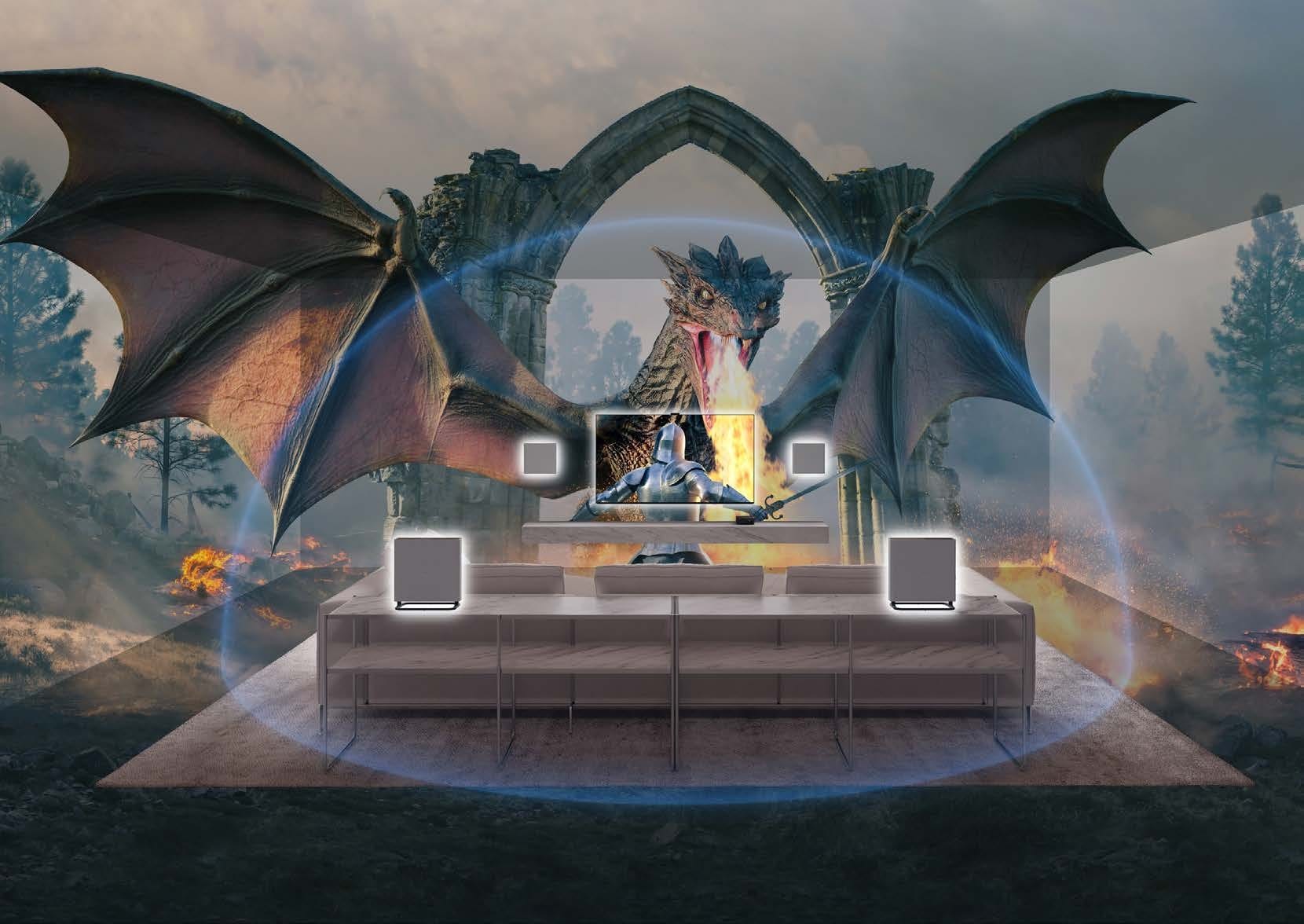
Did you know…that a predecessor to the Theatre Quad system we tested already exists? Specifically, it’s the HT-A9 home entertainment system, which also includes four cylindrical speakers and a connection box. Besides a different design, the older generation mainly differs in the number and size of the built-in speakers. The HT-A9 speakers do not include midrange drivers. However, the microphones for room calibration are built into the HT-A9 speakers, so no app or smartphone is needed for this purpose.

The Sony Theatre Quad includes four identical surround speakers and a connection box, which mainly directs sound from the TV or gaming console to the speakers. The speakers have a flat, rectangular design and are fully covered in gray acoustic fabric. This neutral color helps them blend seamlessly into modern homes or against a white wall. The flat black top surface is smooth, with a noticeable perforated section on the left side, where the upward-firing 79 × 36 full-range driver is visible.
Inside each speaker box are three more speakers facing forward: a 19 mm tweeter, a 60 mm midrange driver, and an 80 mm woofer. Each satellite delivers a reference output of 126 watts, bringing the total output for the 4.0.4 system to 504 watts. On the back of the speaker housing, a small flap hides a screw that can be used to attach the included wall hook for wall mounting. Alternatively, the included base can be attached to the underside to stand the speaker, leaving enough space for the power cable. The slim, square Theatre Quad speakers are impeccably crafted with no defects. The unusual design is instantly appealing.
“4.0.4 surround set from Sony offers true Dolby Atmos sound, Wi-Fi, and Bluetooth 5.2”
Technical Data
The set also includes a black connection box, which has a compact, square design and resembles the Vodafone Giga TV Home Sound. It features an HDMI 2.1 ARC/eARC TV port, an additional HDMI input for connecting external devices like a gaming console or satellite receiver, and an S-Center output, useful only for owners of modern Sony Bravia TVs like the XR65A80LAEP. This port allows the TV to function as the system’s central center speaker, improving speech clarity and voice localization.
The back of the connection box includes a power button, and the front features a graphic display that shows input source or volume level. A small LED strip at the bottom edge indicates device status. The nearly 800-gram connection box is well-designed and well-made, fitting seamlessly into any TV setup. An external subwoofer is not included but can be added, such as the Sony SA-SW5.
Setup
Setting up Sony’s surround system is just as easy as with a traditional sound bar. You simply need to power the satellite speakers and connect the control box to the TV with an HDMI cable, then select the appropriate input source. Like the Sony Bravia Theatre Bar 9 we reviewed, it offers an HDMI ARC/eARC port and an additional HDMI input for connecting other source devices. However, it lacks an optical S/PDIF input. Pairing the components happens automatically, although each speaker has a Link button in case of connection issues. To prevent this, each speaker has two antennas and new processors that automatically select the correct wireless channel for a stable connection.
Before setup, you’ll need to decide whether to mount the speakers on the wall or use the stand bases. The elliptical base can be mounted on the wall with additional brackets or attached to the underside of the speakers, leaving enough space for the power cable between the base and housing.
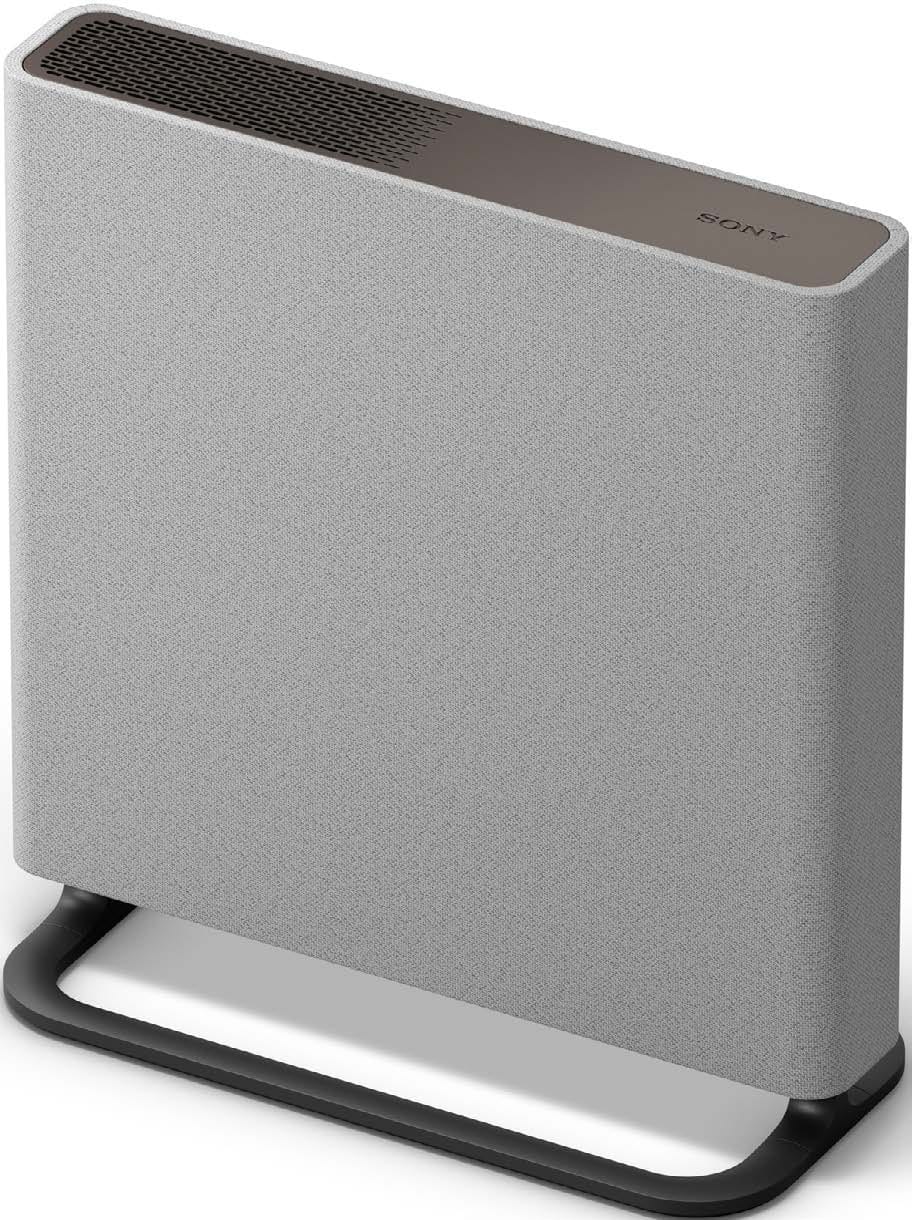

Operation and Features
To fully optimize the surround system, especially the sound, you’ll need the free Sony Bravia Connect app, which includes a useful room calibration feature that uses your smartphone’s microphone. Once setup is complete, the included infrared remote control, with buttons for all the basic functions including bass adjustment, Night and Voice modes, input source selection, and toggling the Sound Field function, is all you’ll need for everyday use. Fortunately, the aforementioned display provides all necessary information on selected settings, so the app isn’t essential, although it does improve overall clarity.
The four-speaker set includes Bluetooth 5.2, Wi-Fi (802.11ac – 2.4 & 5 GHz), AirPlay, and Spotify Connect. The Bravia Theatre Quad offers two HDMI ports supporting important gaming formats, including VRR, ALLM, and SBTM, as well as 8K/60 Hz and 4K/120 Hz, the HDR formats HDR10 and Dolby Vision, and the audio formats Dolby Atmos and DTS:X. For music playback, the system also supports Hi-Res Audio and 360 Reality Audio content. However, NFC, Multiroom, and voice control are not available, and Chromecast is missing, which was present in the HT-A9 predecessor model.
Sound Modes and Quality
Instead of typical genre-based sound modes, Sony’s Theatre Quad system focuses on a Night mode, which reduces loud sounds, a Voice mode that enhances clarity, and the “Sound Field” function for a wider soundstage. You can also adjust the bass intensity in three levels. These settings can be controlled through the app or the compact remote control. For the “360 Spatial Sound Mapping” feature, however, the Bravia Connect app is necessary to create an optimal 360-degree immersive sound experience.
In our sound test, we started with the latest Planet of the Apes film, “New Kingdom.” From the very first scene, where Noa and his clan members set out to steal eggs from an eagle’s nest, we were amazed by the impressive Dolby Atmos surround sound as birds flew around the screen and above the protagonists’ heads, creating a fully immersive experience. This sense of presence continued throughout the jungle scene, with various animal sounds coming from all directions.
In the first major action scene, where Noa’s village is attacked and set on fire, the entire room was filled with the sound of crackling and explosions, delivering an extremely immersive cinematic experience. Home theater fans will also enjoy the final battle in “Avengers: Endgame,” which we experienced with true Dolby Atmos sound. The battle sequences, both visually and audibly, pulled us into the heart of the action. Despite the intense sound effects, the dialogue remained clear, even during action-packed moments. In quieter scenes, the sound was dynamic, balanced, and expansive. The only downside was the bass, which lacked some punch at times and could benefit from an additional subwoofer.
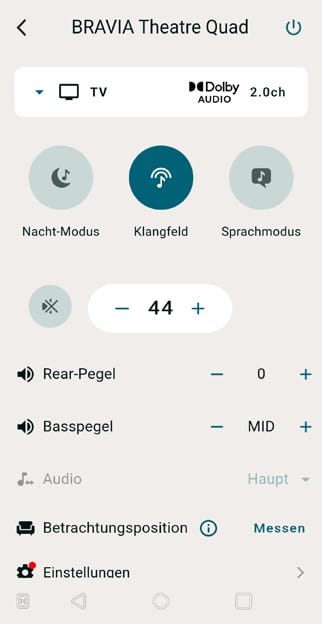
Sony Bravia Connect App The Sony Bravia Connect app guides users through the initial setup with simple, clear instructions. The app has a clean layout, providing an overview of sound settings and audio formats. It also includes an automatic sound field optimization feature, which adjusts the surround sound to your specific room layout.
The Quad system is also great for gaming, so we tested it with the racing simulator Gran Turismo 7. Most of the loud sound effects came from the front speakers, but the overall experience was enhanced, especially in tight races, where the roar of approaching competitors’ engines could be precisely located in the 3D sound space. For those who want an even more immersive gaming experience, Sony’s four-speaker set is an excellent choice, and you can connect your PS5 or Xbox directly to the sound system’s control box. As mentioned earlier, it supports 4K images at up to 120 Hz and includes various gaming features.
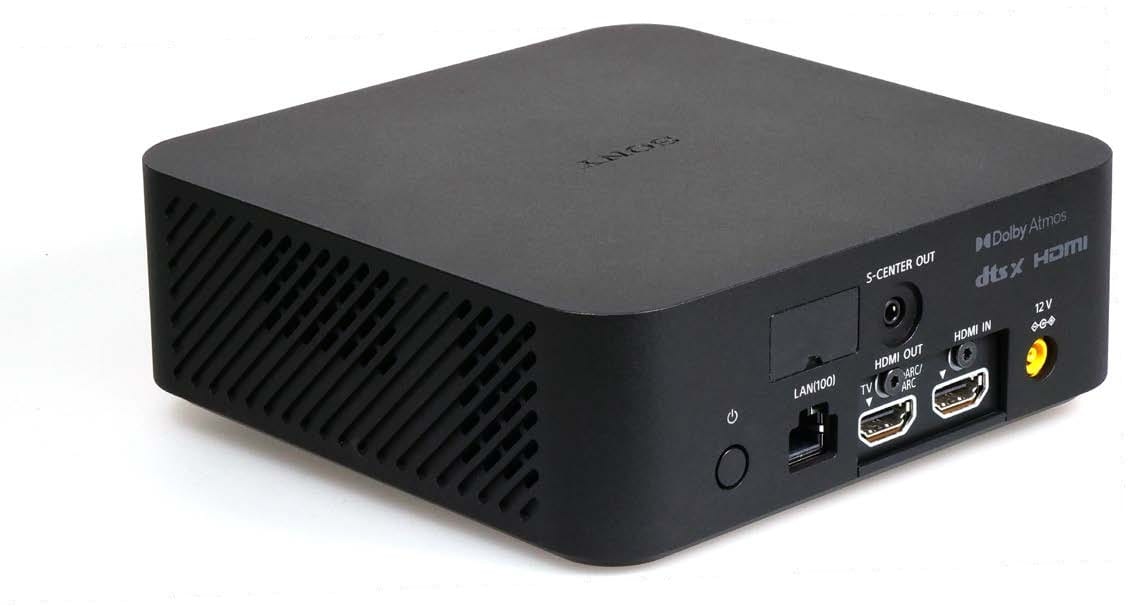
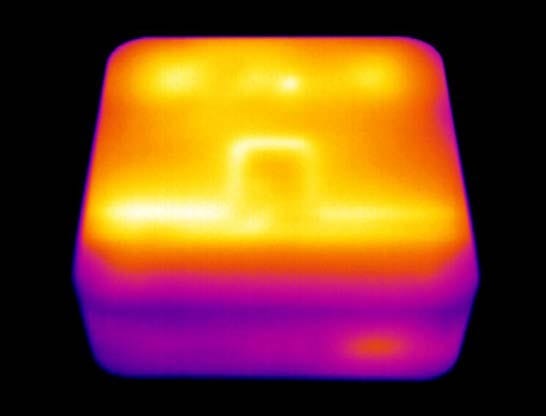
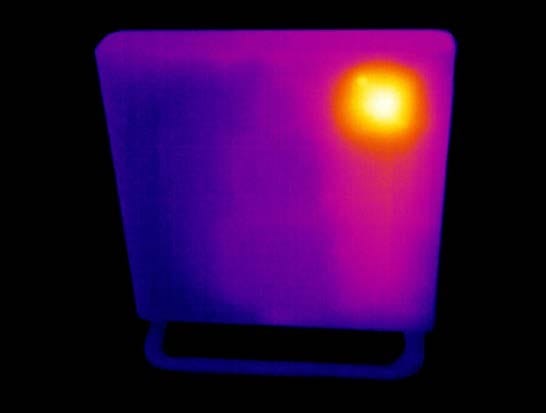
Finally, we tested the 4.0.4 system’s music performance with pop hits like “Timber” by Pitbull & Ke$ha and “Am I Wrong” by Nico & Vinz. The “Sound Field” feature is definitely worth using, as it delivers a more cohesive and fuller sound, bringing all four speakers together in a perfectly immersive soundscape. Without this feature, the sound feels more front-heavy.
For rock songs like “These Days” by Bon Jovi, the bass level should be set to at least medium or high to ensure enough punch. Overall, the bass performance is solid, though very bass-heavy tracks like “Angel” by Massive Attack could benefit from a bit more depth. Despite this, the bass is precise and sufficiently powerful, fitting well into the overall sound. The same goes for the strong mids and crystal-clear highs. If you enjoy listening to audiobooks, the Theatre Quad system works well here too, with excellent voice clarity, making it unnecessary to activate the Voice mode. The Sony system also supports High-Resolution Audio, allowing you to enjoy music as intended by the artist.
Specs
| Product Name | Sony Theatre Quad (HT-A9M2) |
| System Type | 4.0.4 Surround Sound System |
| Total Output Power | 504 watts |
| Satellite Speaker Output | 126 watts per speaker |
| Speaker Drivers | 4 drivers per speaker (1 upward-firing, 1 tweeter, 1 midrange, 1 woofer) |
| Tweeter Size | 19 mm |
| Midrange Driver Size | 60 mm |
| Woofer Size | 80 mm |
| Connectivity | Wi-Fi (802.11ac), Bluetooth 5.2, AirPlay, LAN (100 Mbps), Spotify Connect |
| Supported Audio Formats | Dolby Atmos, DTS , Hi-Res Audio, 360 Reality Audio |
| Supported Video Formats | 4K/120 Hz, 8K/60 Hz, HDR (HDR10, HLG, Dolby Vision) |
| Control Box | HDMI 2.1 ARC/eARC, HDMI input, S-Center output, Ethernet, display with LED status light |
| Additional Features | 360 Spatial Sound Mapping, Sound Field Expansion, App control (Sony Bravia Connect App) |
| Subwoofer | Not included (compatible with Sony SA-SW5, available separately) |
| Remote Control | Infrared remote with basic functions (volume, input source, Sound Field, Night/Voice mode) |
| Mounting Options | Wall-mountable with included wall hooks or can be placed on a surface with base stands |
| Power Supply | Individual power adapters for each speaker and control box |
| Dimensions (Control Box) | 16 × 5.6 × 16 cm (W × H × D) |
| Weight (Control Box) | 800 grams |
| Weight (Speakers) | Approximately 2.7 kg each |
Conclusion
The Sony Bravia Theatre Quad stands out for its flexibility, as all four speaker boxes can be positioned throughout the room, either mounted on the wall or placed on a surface, making it ideal for irregularly shaped living spaces. The sound is balanced and powerful for both music and movies.
Additionally, the Dolby Atmos system delivers a true 3D sound experience, with sound reflections from the ceiling that immerse you in the action. The only minor drawback is the bass, which could use a bit more impact, something that could be resolved with an external subwoofer.
Aside from that, the 4.0.4 system performs excellently. The Sony Bravia Quad System is a great improvement over its predecessor, featuring easy setup, a wide range of functions including Wi-Fi, Bluetooth, AirPlay, Hi-Res Audio, and Spotify Connect. Overall, the Bravia Theatre Quad from Sony earns a strong score of 9.4 out of 10, with a “very good” rating. However, the price is quite steep.
When you purchase through links on our site, I may earn an affiliate commission. Here’s how it works.













